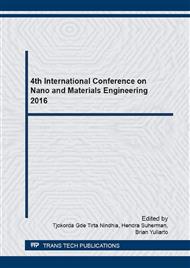[1]
Podlogar M, Richardson J. J, Vengust D, Daneu N, Samadzjja Z, Bernik S, Recnik, Growth of Transparent and Conductive Polycrystalline (0001)-ZnO Films on Glass Substrates Under Low-Temperature Hydrothermal conditions, Advanced Functional Materials, 22 (2012).
DOI: 10.1002/adfm.201200214
Google Scholar
[2]
R. Lachaume, W. Favre, P. Scheiblin, X. Garros, N. Nguyen, J. coignus, D. Munoz, G. Reimbold, Influence of a-Si: H/ITO interface properties on performance of heterojunction solar cells, Energy Procedia, 38 (2013) 770-776.
DOI: 10.1016/j.egypro.2013.07.345
Google Scholar
[3]
L. Liu, S. Mam, H. Wu, B. Zhu, H. Yang, J. Tang, X. Zhao, Effect of the annealing process on electrical and optical properties of SnO2/Ag/SnO2 nanometric multilayer film, Materials Letters, 149 (2015) 43-46.
DOI: 10.1016/j.matlet.2015.02.093
Google Scholar
[4]
Q. Wan, E.N. Dattoli, W. Lu, Transparent metallic Sb-doped SnO2 nanowires, Applied Physics Letters, 90 (2007) 222107.
DOI: 10.1063/1.2743746
Google Scholar
[5]
S. Yu, W. Zhang, L. Li, D. Xu, H. Dong, Y. Jin, Optimization of SnO2/Ag/SnO2 tri-layer films as transparent composite electrode with high figure or merit, Thin Solid Films, 552 (2013) 150-154.
DOI: 10.1016/j.tsf.2013.11.109
Google Scholar
[6]
H.J. Kim, K.W. Seo, Y.H. Kim, J.Y. Choi, H.K. Kim, Direct laser patterning of transparent ITO-Ag-ITO multilayer anodes for organic solar cells, Applied Surface Science, 328 (2014) 215-221.
DOI: 10.1016/j.apsusc.2014.12.017
Google Scholar
[7]
D.R. Sahu, S.Y. Lin, J.L. Huang, ZnO/Ag/ZnO multilayer films for the application of a very low resistance transparent electrode, Applied Surface Science, 252 (2006) 7509-7514.
DOI: 10.1016/j.apsusc.2005.09.021
Google Scholar
[8]
A.E. Hajj, B. Lucas, M. Chakaroun, R. Antony, B. Ratier, M. Aldissi, Optimization of ZnO/Ag/ZnO multilayer electrodes obtained by ion beam sputtering for optoelectronic devices, Thin Solid Films, 520 (2012) 4666-4668.
DOI: 10.1016/j.tsf.2011.10.193
Google Scholar
[9]
D. R. Sahu, J.L. Huang, Experimental and theoretical analysis of ZnO/Au/AnO transparent conducting thin films, Thin Solid Films, 516 (2008) 4728-4832.
DOI: 10.1016/j.tsf.2007.08.089
Google Scholar
[10]
C. H. Hong, Y. J. Jo, H.A. Kim, J.H. lee, J.S. Kwak, Highly flexible ZnO/Ag/ZnO conducting electrode for organic photonic devices, Thin Solid Films, 519 (2011) 6829-6833.
DOI: 10.1016/j.tsf.2011.01.220
Google Scholar
[11]
X. He, W. Wang, S. Li, Y. Liu, W. Zheng, Q. Shi, X. Luo, Growth parameter-property phase diagram for pulsed laser deposited transparent oxide conductor anatase Nb: TiO2, Vacuum, 120 (2015) 17-21.
Google Scholar
[12]
J.H. Kim, J.H. Lee, S.W. Kim, Y.Z. Yoo, T.Y. Seong, Dependence of optical and electrical properties on Ag thickness in TiO2/Ag/TiO2 multilayer films for photovoltaic devices, Ceramic International, 41 (2015) 7146-7150.
DOI: 10.1016/j.ceramint.2015.03.002
Google Scholar
[13]
S.X. Zhang, S. Dhar, W. Yu, H. Xu, S.B. Ogale, T. Vendatesan, Highly transparent and infrared reflective Al-doped ZnO(AZO)/Ag/AZO multilayer film prepared on PET substrate by RF magnetron sputtering, Applied Physics Letters, 91 (2007) 112113.
DOI: 10.1016/j.vacuum.2014.02.021
Google Scholar
[14]
J.H. Kim, H.K. Lee, J.Y. Na, S.K. Kim, Y.Z. Yoo, T.Y. Seong, Infrared reflective properties of AZO/Ag/AZO trilayers prepared by RF magnetron sputtering, Ceramic International, 41 (2015) 8059-8063.
DOI: 10.1016/j.ceramint.2014.04.139
Google Scholar
[15]
D. Miao, S. Jiang, S. Shang, Z. Chen, V, Optimization of Nb2O5/Ag/Nb2O5 multilayers as transparent composite electrode on flexible substrate with high figure of merit, Vacuum, 106 (2014) 1-4.
DOI: 10.1063/1.4767662
Google Scholar
[16]
D. Miao, S. Jiang, S. Shang, Z. Chen, Infrared reflective properties of AZO/Ag/AZO trilayers prepared by RF magnetron sputtering, Ceramics International, 40 (2014) 12847-12853.
DOI: 10.1016/j.ceramint.2014.04.139
Google Scholar
[17]
A. Dhar, T.L. Alford, Optimization of Nb2O5/Ag/Nb2O5 multilayers as transparent composite electrode on flexible substrate with high figure of merit, Journal of Applied Physics, 112 (2012) 103113.
DOI: 10.1063/1.4767662
Google Scholar
[18]
S. Venkatachalam, H. Nanjo, K. Kawasaki, Y. Wakui, H. Hayashi, T. Ebina, Preparation and characterization of naanocrystalline ITO thin films on glass and clay substrates by ion-beam sputter deposition method, Applied Surface Science, 257 (2011).
DOI: 10.1016/j.apsusc.2011.05.065
Google Scholar
[19]
G. Haacke, New figure of merit for transparent conductors, Journal of Applied physics, 47 (1976) 4086.
DOI: 10.1063/1.323240
Google Scholar


